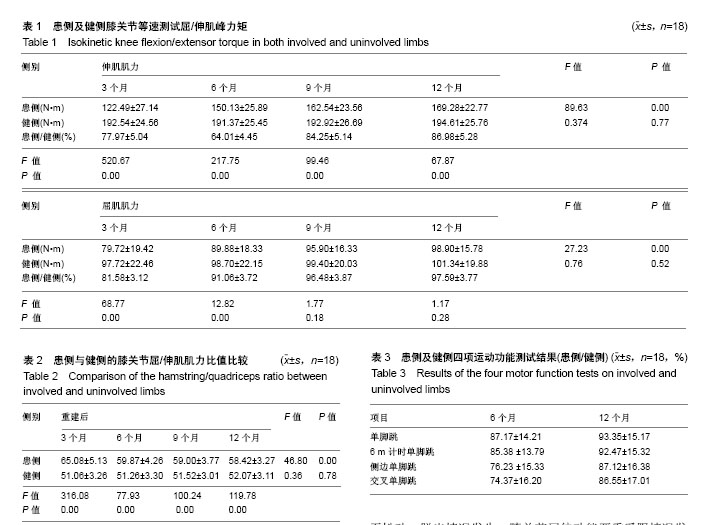| [1] Brady MP. Clinical diagnostic tests versus MRI diagnosis of ACL tears. J Sport Rehabil. 2017;15:1-14.[2] Mather RC, Koenig L, Kocher MS, et al. Societal and economic impact of anterior cruciate ligament tears. J Bone Joint Surg. 2013; 95:1751-1759.[3] Tourville TW, Jarrell KM, Naud S, et al. Relationship between isokinetic strength and tibiofemoral joint space width changes after anterior cruciate ligament reconstruction. Am J Sports Med. 2014;42:302-311. [4] Chung KS, Ha JK, Ra HJ, et al. Does synovialization after anterior cruciate ligament reconstruction have a positive effect on functional performance, outcomes scores, stability and muscle strength? A 2-year follow-up study after reconstruction. Arch Orthop Trauma Surg. 2017;137(12):1725-1733[5] Burks RT, Crim J, Fink BP, et al. The effects of semitendinosus and gracilis harvest in anterior cruciate ligament reconstruction. Arthroscopy.2005;21:1177-1185.[6] Keays SL, Bullock-Saxton J, Keays AC, et al. Muscle strength and function before and after anterior cruciate ligament reconstruction using semitendinosus and gracilis. The Knee. 2001; 8: 229-234.[7] Chao WC, Shih JC, Chen KC, et al. The effect of functional movement training after anterior cruciate ligament reconstruction-a Randomized controlled trial. J Sport Rehabil. 2017;24:1-18.[8] Hsiao SF, Chou PH, Hsu HC, et al. Changes of muscle mechanics associated with anterior cruciate ligament deficiency and reconstruction. J Strength Cond Res. 2014;28:390-400.[9] Knezevic OM, Mirkov DM, Kadija M, et al. Evaluation of isokinetic and isometric strength measures for monitoring muscle function recovery after anterior cruciate ligament reconstruction. J Strength Cond Res. 2013;28:1722-1731.[10] Knezevic OM, Mirkov DM, Kadija M, et al. Asymmetries in explosive strength following anterior cruciate ligament reconstruction. Knee.2014;21(6):1039-1045.[11] Pamukoff DN, Pietrosimone BG, Ryan ED, et al. Quadriceps function and hamstrings co-activation after anterior cruciate ligament reconstruction. J Athl Train. 2017;52:422-428.[12] Setuain I, Izquierdo M, Idoate F, et al. Differential effects of two rehabilitation programs following anterior cruciate ligament reconstruction. J Sport Rehabil. 2016;19:1-37. [13] Kuenze C, Hertel J, Hart JM. Effects of exercise on lower extremity muscle function after anterior cruciate ligament reconstruction. J Sport Rehabil. 2013;22(1):33-40.[14] Goetschius J. Knee-extension torque variability and subjective knee function in patients with a history of anterior cruciate ligament reconstruction. J Athl Train. 2016;51:22-27[15] Hohmann E, Bryant A. Strength does not influence knee function in the ACL-deficient knee but is a correlate of knee function in the and ACL-reconstructed knee. J Orthop Trauma.2016; 136(4): 477-483.[16] Wipfler B, Donner S, Zechmann CM, et al. Anterior cruciate ligament reconstruction using patellar tendon versus hamstring tendon: a prospective comparative study with 9-year follow-up. Arthroscopy. 2011;27:653-665.[17] Kim DK, Park WH. The correlation of the evaluation of quality of life depends on knee strength after 1-year anterior cruciate ligament reconstruction. J Kor Sports Med.2014; 32: 139-143. [18] Hortobagyi T, Westerkamp L, Beam S, et al. Altered hamstring-quadriceps muscle balance in patients with knee osteoarthritis. Clin Biomech (Bristol, Avon). 2005; 20: 97-104.[19] Kim HJ, Lee JH, Ahn SE, et al. Influence of anterior cruciate ligament tear on thigh muscle strength and hamstring-to-quadriceps ratio: a Meta-analysis. PLoS One. 2016;11:e0146234. [20] Adams D, Logerstedt DS, Hunter-Giordano A, et al. Current concepts for anterior cruciate ligament reconstruction: a criterion-based rehabilitation progression. J Orthop Sports Phys Ther. 2012;42(7):601-614.[21] Kadija M, Knezevi? OM, Milovanovi? D, et al. The effect of anterior cruciate ligament reconstruction on hamstring and quadriceps muscle function outcome ratios in male athletes. Srp Arh Celok Lek. 2016;144(3-4):151-157.[22] Fischer F, Fink C, Herbst E, et al. Higher hamstring-to-quadriceps isokinetic strength ratio during the first post-operative months in patients with quadriceps tendon compared to hamstring tendon graft following ACL reconstruction. Knee Surg Sports Traumatol Arthrosc. 2018;26(2):418-425. [23] Streich NA, Friedrich K, Gotterbarm T. Reconstruction of the ACL with a semitendinosus tendon graft: a prospective randomized single blinded comparison of double-bundle versus single-bundle technique in male athletes. Knee Surg Sports Traumatol Arthrosc . 2008;16:232-238.[24] Ardern CL, Webster KE, Taylor NF. Return to the preinjury level of competitive sport after anterior cruciate ligament reconstruction surgery: two-thirds of patients have not returned by 12 months after surgery. Am J Sports Med. 2011;39:538-543.[25] Ardern CL, Taylor NF, Feller JA. Return-to-sport outcomes at 2 to 7 years after anterior cruciate ligament reconstruction surgery.Am J Sports Med. 2012;40:41-48. [26] Goetschius J, Kuenze CM, Hart JM. Knee extension torque variability after exercise in ACL reconstructed knees. J Orthop Res. 2015;33(8):1165-1170.[27] Xergia SA, Pappas E. Association of the single-limb hop test with Isokinetic, kinematic, and kinetic asymmetries in patients after anterior cruciate ligament reconstruction. Sports Health. 2015;7: 217-223. [28] Lepley LK. Deficits in quadriceps strength and patient-oriented outcomes at return to activity after ACL reconstruction: a review of the current literature. Sports Health. 2015;7:231-238.[29] Hsieh CJ, Indelicato PA, Moser MW, et al. Speed, not magnitude, of knee extensor torque production is associated with self-reported knee function early after anterior cruciate ligament reconstruction. Knee Surg Sports Traumatol Arthrosc. 2015; 23(11):3214-3220.[30] Camp CL, Lebaschi A, Cong GT, et al. Timing of postoperative mechanical loading affects healing following anterior cruciate ligament reconstruction: analysis in a murine model. J Bone Joint Surg Am. 2017;99:1382-1391.[31] Hart JM,Pietrosimone B,Hertel J.Quadriceps activation following knee injuries: a systematic review.J Athl Train 2010;45:87-97.[32] Konishi Y,Ikeda K,Nishino A,et al.Relationship between quadriceps femoris muscle volume and muscle torque after anterior cruciate ligament repair.Scand J Med Sci Sports 2007; 17:656-661.[33] Abrams GD, Harris JD, Gupta AK, et al. Functional performance testing after anterior cruciate ligament reconstruction: a systematic review. Orthop J Sports Med. 2014;21;2(1): 2325967113518305. .[34] Nicky EM, Robert EH, Tony G. Functional performance 2–9 years after ACL reconstruction: cross-sectional comparison between athletes with bone–patellar tendon–bone, semitendinosus/gracilis and healthy controls. Knee Surg Sports Traumatol Arthrosc. 2017; 25:1-12. |
.jpg)


.jpg)